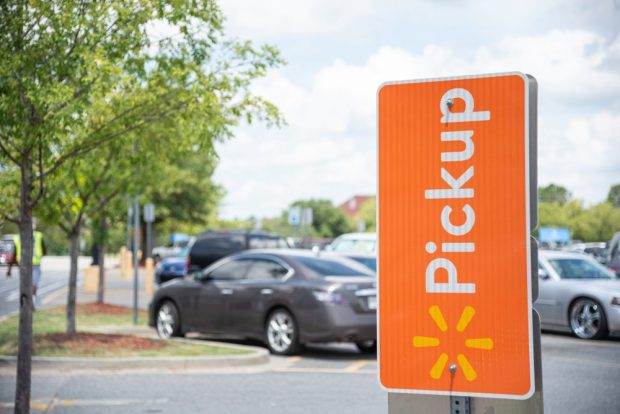Amazon, Walmart Square Off Over Rise in Curbside and In-Store Pickup

Evolving online search tools and a growing consumer shift toward faster pickup options are raising the digital stakes between Amazon and Walmart. Whether it’s curbside or in-store, the 2-day delivery model is clearly facing increased pressure.
This, at a time when PYMNTS’ 2023 Global Digital Shopping Index has not only shown that roughly half of consumers now shop with a smartphone in-hand but that nearly one-third of U.S. consumers surveyed said they fetched their most recent online order themselves, either via curbside or in-store options.
“Year over year, 26% more consumers across the five countries we studied used BOPIS options in 2022, as consumers appeared to favor the certainty and cost-effectiveness of pickup, and more merchants integrated pickup options into their order flows,” the study stated, noting that the rate of buy online, pick up in-store (BOPIS) and curbside pickup options in the U.S. were up 37% versus a year ago.
What to do About It?
While the study of 13,000 consumers in six countries irrefutably quantifies this evolving trend, the retail response from Amazon, Walmart and other major brands — both in the U.S. and abroad — is far more nuanced and complicated.
For example, Amazon’s response to faster delivery is obviously geared toward its newly doubled network of fulfillment centers that it is currently trying to grow into while also looking to find new efficiencies that are in keeping with its “maniacally focused” efforts toward improving the customer experience.
“So, when you do both of those things to meet this huge surge in demand, just to get those functional, it took everything we had,” Amazon CEO Andy Jassy said on the company’s Q4 earnings call earlier this month while stressing ongoing efforts to make the digital retail leader more efficient.
“I think the second priority I would talk about is just speed,” Jassy said. “We believe that continuing to get products to customers faster makes customers happier, and they also convert at a higher rate when they can see promises of deliveries that are faster.”
Curbside Recalibration
For Walmart’s part, the path to putting products into customers’ hands more quickly is clearly going to go through its 3,572 US Supercenters, one of which, it often touts, sits less than 10 miles away from 90% of the population.
While that physical location advantage is clear, compared to the digitally dominant and door-step delivery advantage of Amazon Prime, maximizing and streamlining that response will take a major effort and investment.
Walmart has already begun the rollout of its new store format that it announced a year ago, with a string of “grand re-openings” in remodeled stores that focus on helping customers find what they need more quickly and also retools external space to get BOPIS buyers in and out more efficiently.
While general merchandise sales declined by low single digits in the third quarter, Walmart CFO John Rainey told investors in November that the softness in electronics, home and apparel was partially offset by 16% sequential growth in e-commerce alongside continued growth in traditional store transactions.
“We experienced strength in pickup and delivery from stores, Marketplace, fulfillment services and advertising,” Rainey said, while noting the retailer’s other delivery capability enhancements, including a four-fold increase in the number of pickup points serviced by the Spark platform.
To be sure, the consumer BOPIS and curbside trajectory is expected to see further growth and will also likely be a key focus of attention later this month when Walmart reports its 4th quarter results the morning of Feb. 21.
For all PYMNTS retail coverage, subscribe to the daily Retail Newsletter.